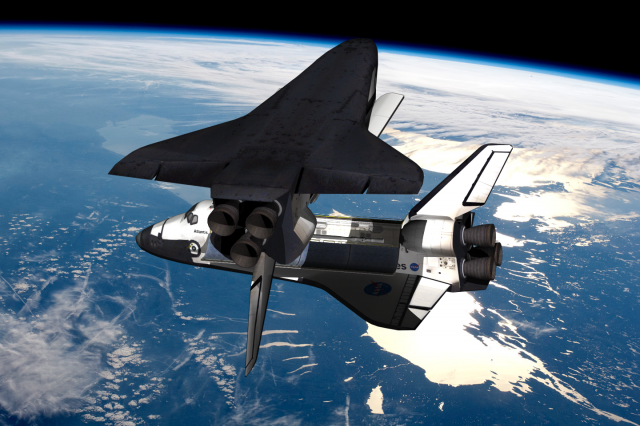
If we die, we want people to accept it. We are in a risky business, and we hope that if anything happens to us, it will not delay the program. The conquest of space is worth the risk of life.
—Astronaut Gus Grissom, 1965
It is important to note at the outset that Columbia broke up during a phase of flight that, given the current design of the Orbiter, offered no possibility of crew survival.
—Columbia Accident Investigation Board Report
At 10:39 Eastern Standard Time on January 16, 2003, space shuttle Columbia lifted off from pad 39A at the Kennedy Space Center in Florida. Just under a minute and a half later, at 81.7 seconds after launch, a chunk of insulating foam tore free from the orange external tank and smashed into the leading edge of the orbiter's left wing at a relative velocity of at least 400 miles per hour (640 km/h). Columbia continued to climb toward orbit.
The foam strike was not observed live. Only after the shuttle was orbiting Earth did NASA's launch imagery review reveal that the wing had been hit. Foam strikes during launch were not uncommon events, and shuttle program managers elected not to take on-orbit images of Columbia to visually assess any potential damage. Instead, NASA's Debris Assessment Team mathematically modeled the foam strike but could not reach any definitive conclusions about the state of the shuttle's wing. The mission continued.
In reality, the impact shattered at least one of the crucial reinforced carbon-carbon heat shield panels that lined the edge of the wing, leaving a large hole in the brittle ceramic material. Sixteen days later, as Columbia re-entered the atmosphere, superheated plasma entered the orbiter's structure through the hole in the wing and the shuttle began to disintegrate.
At Mission Control in Houston, the flight controllers monitoring Columbia's descent began to notice erratic telemetry readings coming from the shuttle, and then all voice and data contact with the orbiter was lost. Controllers continued to hope that they were merely looking at instrumentation failures, even as evidence mounted that a catastrophic event had taken place. Finally, at 9:12 Eastern Time, re-entry Flight Director LeRoy Cain keyed his communications loop and called out a rarely heard order: "Lock the doors."
It was an acknowledgement that the worst had happened; the mission was now in "contingency" mode. The control room was sealed off, and each flight controller began carefully preserving his or her console's data.
Columbia was gone, and all seven of her crew had been killed. NASA refers to this most rare and catastrophic of events as an LOCV—"Loss of Crew and Vehicle."
Frozen
Columbia is lost. There are no survivors.
—President George W. Bush in a national address, 14:04 EST, February 1, 2003
The world of human space flight paused—first to mourn, then to discover what had happened. Congress laid that responsibility on the combined shoulders of the Columbia Accident Investigation Board (referred to, in typical NASA acronym-dependent style, as "the CAIB" or just "CAIB," which rhymes with "Gabe"). In the months after Columbia, the CAIB stretched its investigative fingers all through NASA and its supporting contractors.
My own memories of the time immediately following the accident are dominated by images of somber meetings and frantic work. I was a junior system administrator at Boeing in Houston, and because we supported the shuttle program, we had to locate and send cases and cases of backup tapes—containing everything that happened on every server in our data center during the mission—over to NASA for analysis.
In August 2003, the CAIB issued its final report. Behind the direct cause of the foam strike, the report leveled damning critiques at NASA's pre- and post-launch decision-making, painting a picture of an agency dominated by milestone-obsessed middle management. That focus on narrow, group-specific work and reporting, without a complementary focus on cross-department integration and communication, contributed at least as much to the loss of the shuttle as did the foam impact. Those accusations held a faint echo of familiarity—many of them had been raised 17 years earlier by the Rogers Commission investigating Challenger's destruction.
In the end, Columbia's loss ended not only lives but also careers at all levels of NASA. A number of prominent shuttle program managers were reassigned. It is likely that Columbia's destruction factored heavily into the resignation of NASA Administrator Sean O'Keefe. Many involved with the mission—including many still working at NASA—to this day struggle with post-traumatic stress and survivor's guilt. All pending shuttle missions were put on hold, and Columbia's three surviving sister ships—Discovery, Atlantis, and Endeavour—were grounded.
NASA looked inward, and we wondered if the orbiters would ever fly again.


3175x175(CURRENT).thumb.jpg.b05acc060982b36f5891ba728e6d953c.jpg)

Recommended Comments
There are no comments to display.
Join the conversation
You can post now and register later. If you have an account, sign in now to post with your account.
Note: Your post will require moderator approval before it will be visible.